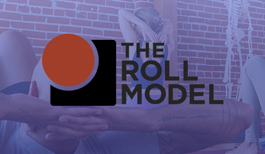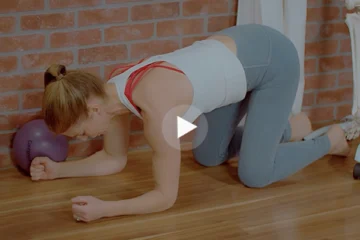
The gastrocnemius has two short heads that extend halfway down the leg where they taper into the calcaneal tendon. The gastrocs give your lower legs their characteristic teardrop shapeliness. The gastrocnemius and soleus muscle form the “triceps surae,” but while the soleus is typically problem-free, the gastrocnemius is often an uncomfortable mess of adhesion.
The gastrocnemius is a total workhorse. It crosses two joints, the knee and the ankle; it originates at the posterior surfaces of the condyles of the femur and inserts at the calcaneus via the calcaneal tendon. Its actions are to flex the knee and plantar flex the ankle.

We use it every time we take a step – that’s about 10,000 times a day – and yet we give it no love. Add to those 10,000 steps all the pedal work in driving and all of the reaching on tiptoe to the back of your cupboards, and you get some sense of how much we depend on this muscle.
Let’s consider walking as our primary action as humans. It’s fundamental to expressing who we are, as a species and as individuals. That makes our feet our interface with the world, and it also makes our feet a host for dysfunction and discomfort.
Tightness or shortness in the gastrocnemius, known as gastrocnemius equinus, can lead to flat feet, unstable ankles, bunions, metatarsalgia, capsulitis, curled fifth toes, hammertoes, sesamoiditis, plantar fasciitis and Achilles tendon inflammation, tendinitis, and even Achilles tendon rupture.
According to medical study, little attention has been paid to the occurrence of gastrocnemius equinus in otherwise healthy individuals. Aside from presenting as the disorders listed above, gastrocnemius equinus may be most notable as a restriction in passive ankle dorsiflexion.
Gastrocnemius equinus is often treated with a night splint, which is like a stiff, open faced boot that forces the ankle into a dorsiflexed position. According to one source, “in truth, however, the main advantage to a night splint for a tight Achilles tendon is the ability to say we tried something conservative before recommending or suggesting a surgery.”
The short form is that if you have discomfort in your feet, you should spend some time with your gastrocs and an Alpha Therapy Ball!
I use an Alpha ball to release adhesion in my gastrocs by sitting on the floor with my legs extended in front of me and resting my right leg on the Alpha ball at the gastroc. Then I cross my left leg over my right, and lift my butt off the floor by pressing down into my hands. Find a tight spot, and take your right foot into plantar flexion to PNF the stretch. (https://aardvarkisrael.com/) Don’t ignore the calcaneal tendon, inferior to the teardrop heads of the gastroc, which is also usually a total mess.
Dr. Kelly Starrett has an effective method of restoring the gastocnemius and calcaneal tendon called the Bone Saw. Check out the video here: http://www.mobilitywod.com/2012/04/introducing-the-bone-saw-calf-smash-redux/
Sources:
http://conejofeet.com/tight-gastrocnemius-foot-pai/
http://www.podiatrytoday.com/understanding-and-managing-equinus-deformities
http://parispedorthic.com/downloads/ibs/Gastrocnemius_Equinus_ParisOrthoticsIB.pdf
http://conejofeet.com/tight-gastrocnemius-foot-pai/
Discover the Yoga Tune Up Alpha Ball
Watch the QuickFix Feet and Ankles Video
Learn more about the Therapy Ball Products












Very informative article. It’s interesting to find that a short gastroc can cause plantar fasciitis and problems with the toes. I love using the Yoga Tune Up balls to stretch my calf muscles.
What a great article outlining the anatomy and function of the gastroc. It is such an important muscle that is often over looked when people had foot ailments. As a physiotherapist I always assess the calf muscle for tightness with any lower extremity pain or dysfunction. As a runner, it is the perfect exercise for me to help with my chronically tight calves! Thank you!
This absolutely worked and made the mess in my left calf disappear – melted like butter after sustained compression with the alpha ball. Now I just need to get better about regular maintenance… When I had researched it months ago, I remember it was noted as a very strong muscle – I have never really thought my calf muscles were particularly strong, and had assumed that I just needed to continue to strengthen them. Seems what I really needed was a good roll!
I really love your description of the importance of this muscle!
Thanks, I really like your article. Good reminder of the interconnect between the gastronemius and how the foot behaves. I will be trying the Alpha ball exercises on this muscle.
Ce muscle méconnu par plusieurs personnes est responsable de plusieurs problèmes physiques. C’est si simple parfois de guérir une douleur physique lorsqu’on connait notre corps et qu’on a en notre possession des balles 🙂
Merci pour cette article sur le muscle gastrocnémien!
Great blog post! As a runner i find this is an area that is particular tender on my body but using the balls there helps so much to loosen the muscle out and remove the tension areas. I Iove the examples you provided of when we use the gastrocnemius — i never thought of its involvement when i am on my tippy toes! Its a good reminder too why heal’s arent a great idea.
Thanks for the post. I have previously used the original Yoga Tune Up therapy balls on my calves but thanks to your post I tried the Alpha and appreciated the difference. I found this technique to more effectively cover the entire calf and in a more efficient manner – always a bonus!
Great explanation for people to be made aware of this part of our leg. People should have no excuse not to “get rolling”
Thanks John! Was discussing this with an athlete today who was complaining of tight calves. Will be using the Alpha during our next session and also happy to have found Kelly’s video on the Bone Saw!
I love this idea of the Alpha Ball for the Gastrocnemius! I typically use the Alpha for the larger muscles and areas of the body, but this sounds like it would allow a tight and tender muscle to slowly release without my body jumping back in “defines” as it usually does when I go after my calves!
I was just asking someone what the alpha ball can be used for yesterday and so happy I found this post. My tight calves will love this technique and I especially love the flossing method shared in Kelly Starrett’s MWOD video.
Thank you for the info and for sharing the technique. I haven’t used the alpha much to target the gastrocnemius so I look forward to experimenting with this. Thanks also for sharing the video – this looks like a great way to get into the gastroc and can’t wait to also give this a try. I have flat feet and also some hammertoe action, so will see if implementing these techniques elicits any change.
I intend to give the therapy balls a try as recommended, mainly to see if some bunion surgery-related foot pain might be alleviated.
Hi John,
I also use balls on my gastrocs and calcaneal tendons (and soleus) with extended knees and 90 degree flexion at the hips and a crossed leg. I don’t, however, know how to do this without constantly losing my balance, so I usually end up putting a dowel between yoga blocks and rolling up and down on that. I use Mr.Starrett’s bone saw, but it hurts like crazy as I have a hard time putting just enough pressure in that position.
In any case, thanks for reminding me I need to give my calves some love.
Thanks John. I love the Alpha Ball and have only been using it on my hamstring area. Everyone who comes to visit me in NYC complains how tired their legs are at the end of the day from walking so much. Now I can sit them down and show them how to stretch for active recovery.
I love ball work. Regardless of how mobile and stereotypically flexible I am, I always manage to find severe sensations in the least expected spots. I initially read this article for someone else. Before instructing this technique to someone else, I had to try it for myself. Wowzah! I couldn’t even take my butt off the ground. Would this be an appropriate technique for someone suffering from compartment syndrome of the calves?
Thanks, John. Many of my older students (me included!) have a variety of problems from their feet on up. In every YTU class I teach I make sure the feet and ankles are handled first before I move on to other anatomical parts. I’ve been looking for creative ways to use the Alpha Ball and will use it on my own gastroc as soon as I complete this reply. My superficial femoral artery completely clogged up about 8 years ago. I don’t know if using the Alpha Ball on a regular basis will or won’t assist the calf muscles to achieve a greater ability to uptake oxygen from the smaller amount of blood that flows into the lower leg, but it’s sure worth a shotl
They were wanting to splint my daughter’s legs due to her toe-walking. Thanks to lots of PT and YTU rolling on her feet and calves we avoided it. I love the bone saw though for myself. Great information!
I used to get so very irritated when my yoga teachers would explain in agonizing detail how to stand properly. They would start with spreading the toes (something I still can’t do), properly balancing your weight over your joints and aligning them correctly. When I was younger, it seemed like such a waste of time. I felt perfect, why was I being asked to change things. Now I’m not younger, and the years of improper use are beginning to make themselves known. It has informed my teaching and way of looking at things. I am quite serious about making sure my students learn to not just move their bodies, but move them in a way that will keep them moving pain free. Just because you can, doesn’t always mean you should has become my mantra!
My mirror neurons are firing all over the place watching that video. I was already imagining the depth of pressure that could be explored with the Alpha Ball. I’ve done the technique you describe with the classic and Plus balls, but not the Alpha. A new frontier has been shown. Thanks for this post!
I’m not sure how i ever missed that Kelly Starrett Bone Saw video, thank you for including it. I also like you’re use of the Alpha ball here, i need to break that bad boy out more often.
Thank you John. Good work! Can’t wait to introduce this exercise into my classes as well as my own personal practice.
Emill:
I definitely include rolling out the plantar fascia in any posterior chain session (soles of feet, calf, hamstring, glutes).
I can’t speak to the design of modern shoes and the complications of ergonomics, but I will definitely be looking into McDougall’s book – thank you! Yes I believe footwear could be a major factor in creating tightness in the Gastroc. I think it’s very important when we come across symptoms such as movement limitation or pain to be open-minded when investigating causes. With human movement we are dealing with complex expression using systems of muscles, which results in a multitude of influences. In the case of the Gastroc, it is responsible for a lot of movement, and so identifying factors of influence will likely be a complicated process without a definitive answer.
I think that any time you come across Gastro Equinus, time spent investigating footwear is time well spent.
My calves are so tight. I usually use the regular size tune-up balls. However, tonight I am going to use the Alpha ball. Great info thank you.
Beautifully comprehensive, John. Understandable even to the less anatomically knowledgeable. One of those “Doh!” moments, once it’s presented this way. Veronica’s point makes this of particular interest to MOST women.
The night splint sounds draconian.
I’m wondering something. If the (assorted) gastrocnemius muscles are tight doesn’t this suggest the foot to be the major issue?
Christopher Mcdougall’s book, “Born to run” makes a compelling argument that most leg/back issues come from the instability of modern footwear. The so-called marshmallow cushioned soles. Wouldn’t rolling out the soles of the feet be called for as well as changing footwear.
Due running and high heels my gastrocs are thight, I’m going to try with the alpha ball, nice advise!
Thank you… Always trying to keep those puppies happy! In the past I’ve used the regular YTU balls …will give Alpha a go!
Thank you Yvonne!
Great blog John. I work with a lot of hockey athletes and they all have tight gastronemius muscles as do most of my clients. I have used the YTU DO-ing method which they found intense especially when using their big toes to tenderize. I can’t wait to try your Alpha Ball exercise on this muscle. Thanks for sharing.